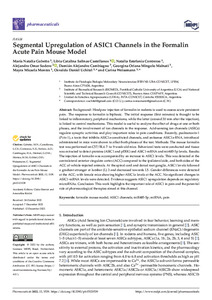Por favor, use este identificador para citar o enlazar este ítem:
https://repositorio.uca.edu.ar/handle/123456789/16062| Título: | Segmental upregulation of ASIC1 channels in the formalin acute pain mouse model | Autor: | Gobetto, María Natalia Salinas Castellanos, Libia Catalina Contreras, Natalia Estefanía Sodero, Alejandro Omar Cambiagno, Damián Alejandro Mingolo Malnati, Georgina Oriana Montes, Mayra Micaela Uchitel, Osvaldo Daniel Weissmann, Carina |
Palabras clave: | CANALES ASIC1; miIR485-5p; miARN; DOLOR; FORMALINA; RATON | Fecha de publicación: | 2022 | Editorial: | Multidisciplinary Digital Publishing Institute | Cita: | Gobetto, M. N. Segmental upregulation of ASIC1 channels in the formalin acute pain mouse model [en línea]. Pharmaceuticals. 2022, 15 (12). doi:10.3390/ph15121539. Disponible en: https://repositorio.uca.edu.ar/handle/123456789/16062 | Resumen: | Abstract: Background: Hindpaw injection of formalin in rodents is used to assess acute persistent pain. The response to formalin is biphasic. The initial response (first minutes) is thought to be linked to inflammatory, peripheral mechanisms, while the latter (around 30 min after the injection), is linked to central mechanisms. This model is useful to analyze the effect of drugs at one or both phases, and the involvement of ion channels in the response. Acid-sensing ion channels (ASICs) regulate synaptic activities and play important roles in pain conditions. Recently, psalmotoxin-1 (Pctx-1), a toxin that inhibits ASIC1a-constituted channels, and antisense ASIC1a-RNA, intrathecal administered in mice were shown to affect both phases of the test. Methods: The mouse formalin test was performed on C57/BL6 7- to 9-week-old mice. Behavioral tests were conducted and tissue was extracted to detect proteins (ASIC1 and pERK) and ASIC1-mRNA and mir485-5p levels. Results: The injection of formalin was accompanied by an increase in ASIC1 levels. This was detected at the contralateral anterior cingulate cortex (ACC) compared to the ipsilateral side, and both sides of the ACC of vehicle-injected animals. At the spinal cord and dorsal root ganglia, ASIC1 levels followed a gradient stronger at lumbar (L) 3 and decreased towards L5. Gender differences were detected at the ACC; with female mice showing higher ASIC1a levels at the ACC. No significant changes in ASIC1-mRNA levels were detected. Evidence suggests ASIC1 upregulation depends on regulatory microRNAs. Conclusion: This work highlights the important role of ASIC1 in pain and the potential role of pharmacological therapies aimed at this channel. | URI: | https://repositorio.uca.edu.ar/handle/123456789/16062 | ISSN: | 1424-8247 | Disciplina: | MEDICINA | DOI: | 10.3390/ph15121539 | Derechos: | Acceso abierto | Fuente: | Pharmaceuticals Vol.15, No.12, 2022 |
| Aparece en las colecciones: | Artículos |
Ficheros en este ítem:
| Fichero | Descripción | Tamaño | Formato | |
|---|---|---|---|---|
| segmental-upregulation-asic1.pdf | 971,84 kB | Adobe PDF |  Visualizar/Abrir |
Visualizaciones de página(s)
54
comprobado en 27-abr-2024
Descarga(s)
41
comprobado en 27-abr-2024
Google ScholarTM
Ver en Google Scholar
Altmetric
Altmetric
Este ítem está sujeto a una Licencia Creative Commons

